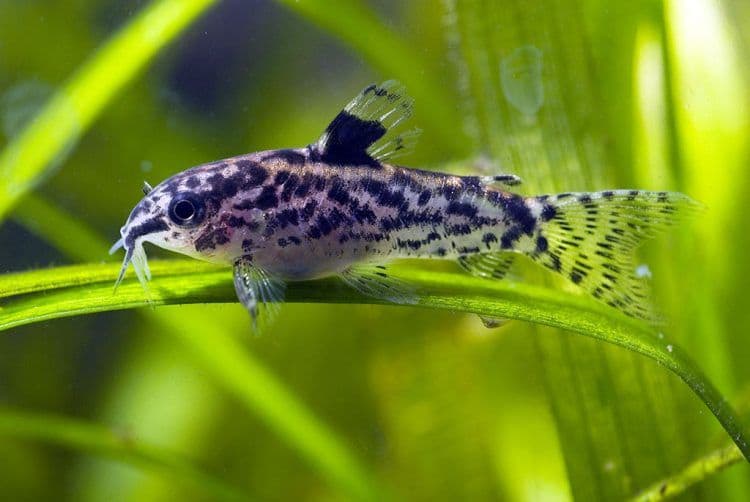
On a recent trip to Calgary, Hans, Gabriel and I stopped at Birgit McKinnon’s place to visit her fishroom. It was a real treat for us. It is a small room but has quite a few tanks in it. Most of the tanks are 5 to 15 gallons. She keeps mostly catfishes, killifish, and of course plants. She is the only person in Alberta that I know that can get the Madagascar lace plant to flower and has been propagating them from seed. On the way out she asked if we would like to take some fish or plants home. Gabriel got twenty Corydoras barbatus juveniles and I got six Aspidoras goia sub-adults. Birgit told me that they are a good cory to start with, so I took her word for it.
I put the goia into a 10-gallon tank with a foam filter. The temperature was set at 80ºF, with straight Edmonton tap water, pH about 7.8 and hard. I fed them sinking pellets, grindal and white worms, and occasionally daphnia. They ate quite eagerly and were not shy, very actively looking for food. Goia belong to the Aspidoras family. They have a slender body and very small eyes compared to the Corydoras family. The goia have a light brown body with dark grey patches all over the body. The males are about two inches long and the females ½-inch longer are rounder. After a month I could sex them, I had two females and four males.
One morning I saw some eggs stuck on the aquarium glass in a few clusters near the filter. I carefully removed them with a razor blade and had about forty eggs. I put them into a margarine container with some water from the parents’ tank and added some methylene blue. The eggs never hatched and most of them fungused. However, they spawned again about a week later and I removed them again in the same way as the first spawn. This time there was one fry for forty eggs, at least I knew the parents were fertile. This lonely fry died a few days later. The third spawn resulted in twenty fry hatching out after three days. They looked like an egg with the tail wiggling constantly. Unfortunately, their bellies got bigger and bigger and they all died of some bacterial disease. I was getting frustrated. Something must have been wrong with my hatching methods. I e-mailed Birgit for help. The goia kept spawning. I took Birgit’s advise and put the eggs in a container with straight undechlorinated tap water and floated the container in the parents’ tank. After three days forty fry hatched. I put them into a container with a hole cut in the side filled with a piece of foam and floated it in the parents’ tank. The air driven tube of the foam filter was placed up into the container to create a constant flow of water. I started feeding them microworms after two days. They looked like little tadpoles about ¼-inch long with one long fin which surrounded the rear half of the light brown body. They grew quite rapidly.
After two weeks, the fry were about ½-inch long and the long fin split into the dorsal, pectoral, anal, and caudal fins. Their bodies were covered with dark spots and they began to look like their parents. I moved them into a 10-gallon tank filled with three inches of water from the parents’ tank. They were fed grindal worms and pellets. I increased the water level slowly, added a foam filter, and some fine sand on the bottom. Birgit feels that sand on the bottom will keep the fry from lying on fungus and debris. After two months the fry were 1¼-inch long and eating the same diet as their parents.
In summary, I found Aspidoras goia an easy fish to keep and spawn. The only requirement for the eggs and fry is clean water. At present, I have over 100 fry from ½-inch to 1½-inches long. The parents are still spawning, but I am leaving the eggs in the tank. The average spawn is 30-60 eggs. The parents do not appear to bother the spawn, but no fry are seen. I think that the fry are much tastier. I am now ready for some more Cory species.
This is a really cute fish. The tiny eyes look really neat. I call them “stretch Corys”, due to the long body versus most Corys. Usually they can be obtained from the auctions and as Mike mentioned they are easy to breed. I would expect that there would be some bags in our upcoming auction. Try them you’ll like them.
Leave a Reply